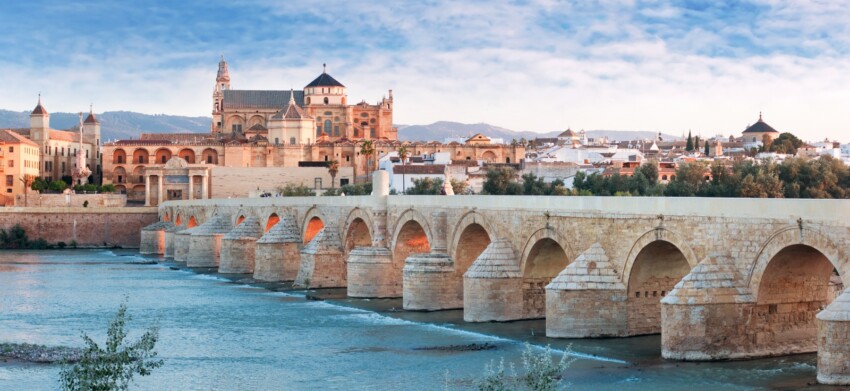

Córdoba is one of the pieces that make up the golden triptych of Andalusia along with Seville and Granada: three cities full of charm, where Spanish and Arab culture exalt each other. Of the three, Cordoba was the capital city of the Muslim empire in Spain and according to some, it is the one that is still most imbued with Arab echoes today.
The city’s landmark building is the Mezquita-Catedral, an architectural gem that leaves all visitors speechless and a precious testimony to a time when Arabs, Catholics and Jews coexisted peacefully. In addition to this unmissable attraction, unanimously considered one of the places to see at least once in a lifetime, there are other splendid palaces that are perhaps less well known but no less fascinating.
Although it is not a city suitable for a beach holiday because it has no outlet to the sea – the nearest beaches are in the province of Malaga – Cordoba is ideal for a slow-paced relaxation trip. Instead of lying in the sun, you can take a nice nap on the patio of your guesthouse surrounded by green plants and flowers.
You’re in the right city for this: the gardens hidden behind the walls of houses are one of Cordoba’s prides and are celebrated every year in the famous Fiesta de los Patios, a competition that rewards the city’s most beautiful patio.
Tapas, romantic views and joie de vivre are not lacking: with the sole exception of the sea, Cordoba is 100% Andalusia.
If you are short on time, it is imperative to prioritise the Mezquita, Cordoba’s most famous attraction. However, there are plenty of things to see in the city, enough to fill more than one day. Keep this in mind when planning your holiday.
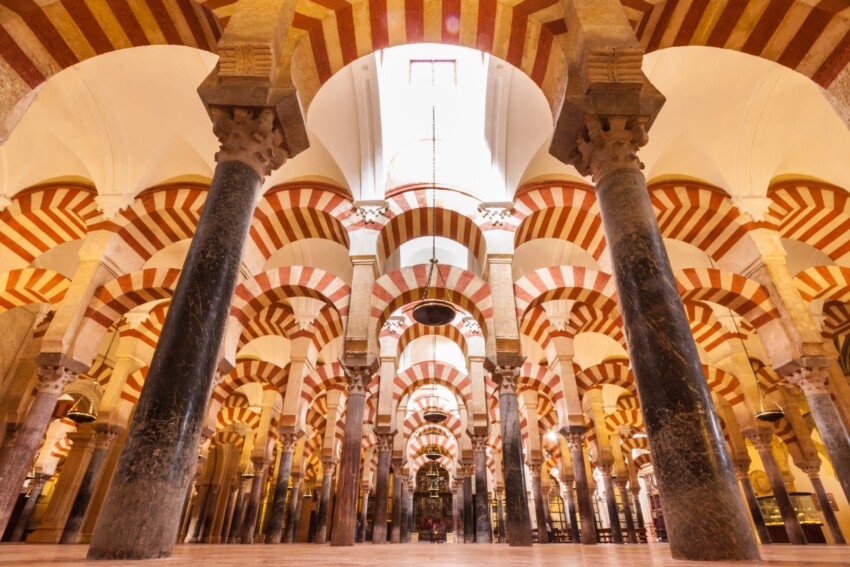
Cordoba’s top attraction is the famous Mezquita, an architectural marvel that enchants millions of visitors every year with its unique mix of Arab and Gothic-Renaissance styles.
It is unquestionably the most important monument in the Islamic West, but to call it a mosque would be reductive. More correct is to call it an imposing religious temple that includes within it Islamic and Christian places of worship (hence the name Mezquita-Catedral) and even some rooms dedicated to the Jewish religion, evidence of a time when the three cultures coexisted harmoniously.
The best known image of the Mezquita of Cordoba is the magnificent prayer hall adorned with hundreds of columns supporting horseshoe-shaped arches of white stone and brick. Symmetries and plays on perspective create a spectacular visual effect overall.
The original core of the Mezquita was built in 785 on the site of the former Basilica of San Vicente, an ancient Visigothic church; over the centuries it was continually enlarged and embellished by first sultans and then Catholic kings.
A visit to the Mezquita-Catedral allows you to admire the Mihrab (a niche dedicated to prayer), the Maqsura (a Muslim chapel), the Catholic Cathedral and the Patio de los Naranjos (a garden with palm, orange and cypress trees). The minaret, later converted into a bell tower, is now an exceptional vantage point from which to admire a splendid view of the city.
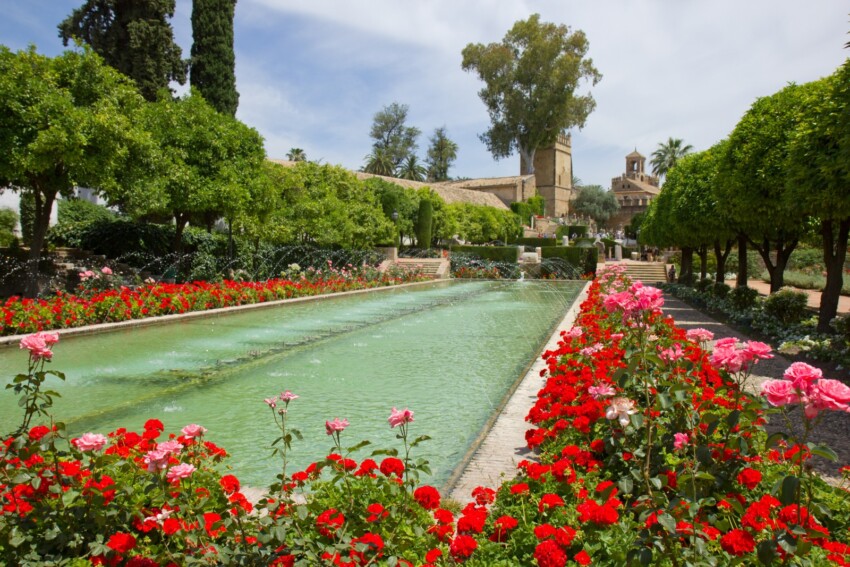
Cordoba’s other landmark building is the Alcazar de los Reyes Cristianos, an Arab-style palace-fortress with Romanesque and Gothic elements where the Catholic kings officially received the sovereigns loyal to the Church; it was here that Isabella and Ferdinand had their first meeting with Christopher Columbus.
The original defensive construction, of Roman origin, was enlarged and embellished by the Arabs with gardens, courtyards, fountains and statues. From the end of the 15th century until the first half of the 19th century, the Alcazar became the headquarters of the Holy Inquisition in Cordoba and numerous rooms were used as prisons and torture chambers; the tower is a symbol of those dark centuries.
Fortunately, strolling through the Alcazar’s lush gardens, one does not feel the slightest echo of that dramatic past: an atmosphere of serenity prevails, inviting relaxation and ecstatic contemplation of beauty.
Opposite the Alcazar are the Baños Califales, which can be accessed with a separate ticket. Although they are not the best-preserved Arab baths in Andalusia, they are well worth a visit. The multitude of rooms and historical exhibits will give you an idea of the importance of the bathing ritual in Arab culture.
The Baños Califales of Cordoba were built in the 10th century and were buried by Christians four centuries later only to be discovered, quite by chance, in 1903.
Also part of the Alcazar complex are the Caballerizas Reales, a building constructed in the second half of the 16th century at the behest of Philip II to house the royal stables.
Today, it is used as a spectacular location for an equestrian show entitled ‘Pasión y Duende del Caballo Andaluz’. Suitable for families, it is a kind of homage to the equestrian tradition of Cordoba and the Andalusian people’s strong bond with the horse.
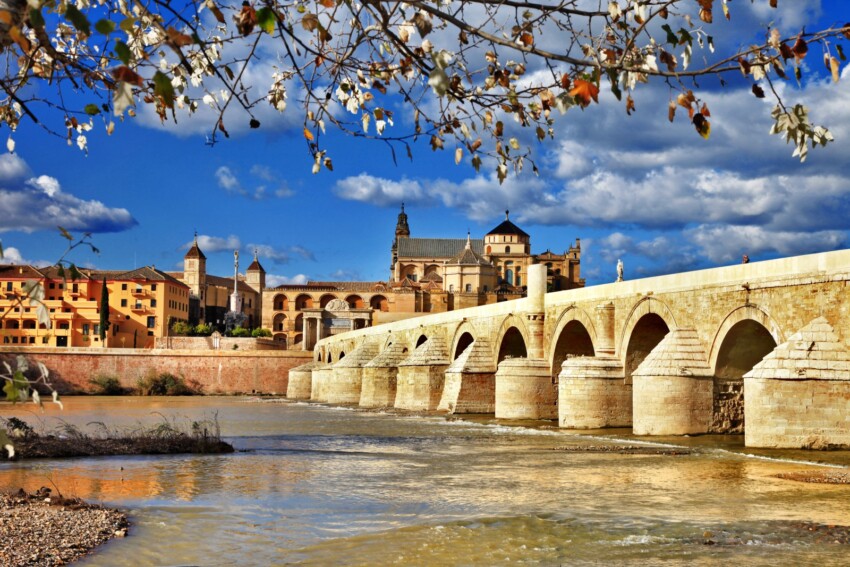
The third architectural masterpiece of Cordoba, after the Mezquita and the Alcazar, is the Roman Bridge, a 16-arched stone bridge over the Guadalquivir River, located just below the Mezquita. It was built by the Romans as part of the Via Augusta that crossed Spain from north to south, connecting what are now the cities of Girona and Cadiz.
The bridge is closed to traffic and is an ideal place for relaxing walks; beautiful to photograph, especially in the evening, it is also a great spot from which to take pictures of the exterior of the Mezquita.
The southern end of the Roman bridge is marked by the Torre de la Calahorra, a tall square defensive construction with crenellated towers built by the Arabs.
The tower currently houses the Museo Vivo de Al-Andalus, an interactive exhibition designed to immerse visitors in the culture and atmosphere that forged the identity of Islamic Spain.
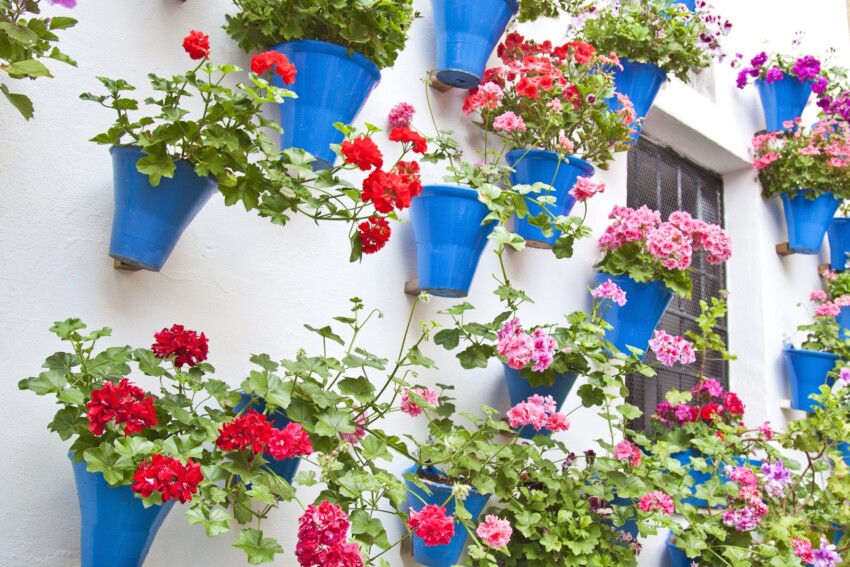
The Jewish Quarter is not only one of the most beautiful areas of Cordoba, but also one of the most fascinating neighbourhoods in all of Spain. Strolling aimlessly and without a watch through the narrow streets of the Juderia is one of the most memorable experiences you can have in Cordoba.
Picturesque glimpses await you at every turn and it is almost certain that you will want to photograph each of the delightful white flower-adorned houses that appear before your eyes.
There are also some important historical buildings within the Juderia. If you have enough time, we recommend that you go and see them. One of them is definitely worth a mention, the Synagogue, built in 1315 and used as a place of worship until 1492, the year that marked the expulsion of the Jews from Spain.
Despite its small size, it represents the most important testimony of Jewish culture in medieval Andalusia. Pay attention to the magnificent stucco decorations depicting quotations in Hebrew and elaborate floral and astrological motifs in the Mudejar style.
Another sumptuous building to visit during your visit to Cordoba is the Palacio de Vania, an aristocratic house built in the late 16th century and named after its last inhabitants, the Marquises of Viana. It was inhabited until 1980.
The palace’s top attraction are its beautiful gardens. With a single admission ticket, you can retrace the history of Cordoba’s patios: from the patio de vecino of the Middle Ages, an example of popular architecture, to the opulent and well-kept patios of the Renaissance, designed to give an image of power and wealth.
The meeting point between Cordoba’s fascinating historical heart and the city’s dynamic commercial area is the pedestrian Plaza de las Tendillas.
It is not one of Cordoba’s most characteristic sights, but it is worth a visit to have a look. For the inhabitants of Cordoba, it plays an important role: it is a place of passage and a meeting place, and it is also where New Year’s Eve celebrations and some of the city’s most important events are held.
In the centre of the square is a fountain with an equestrian statue depicting a famous Spanish general.
Although lively and colourful, animated at all hours from morning to late evening, Cordoba’s Mercado Victoria cannot exactly be described as a popular market.
Housed inside a 19th century glass and wrought iron pavilion in a city park, the Victoria is a covered market that has set its own tone. Far from fruit and vegetable stalls, in this elegant food court you will find sushi restaurants, grill bars, cocktail bars, trendy cafés and even a disco.
There is no shortage of opportunities to sample Spanish specialities, both traditional and creative versions.
The Centro Flamenco Fosforito in Cordoba is considered one of the best museums dedicated to flamenco in all of Spain: if you have an interest in this passionate dance, don’t miss it.
Through videos, information panels and memorabilia, the exhibition will take you through the history of the flamenco guitar and the great protagonists of the music and dance; you will learn about the different styles and can try your hand at a performance.
The museum is housed in the historic Posada del Potro inn mentioned by Cervantes in Don Quixote.
Recommended only for history buffs, the Archaeological Museum of Cordoba traces the history of the city from pre-Roman times to the beginning of the Reconquista. The entrance ticket also includes a visit to the remains of a Roman theatre excavated in the museum’s basement.
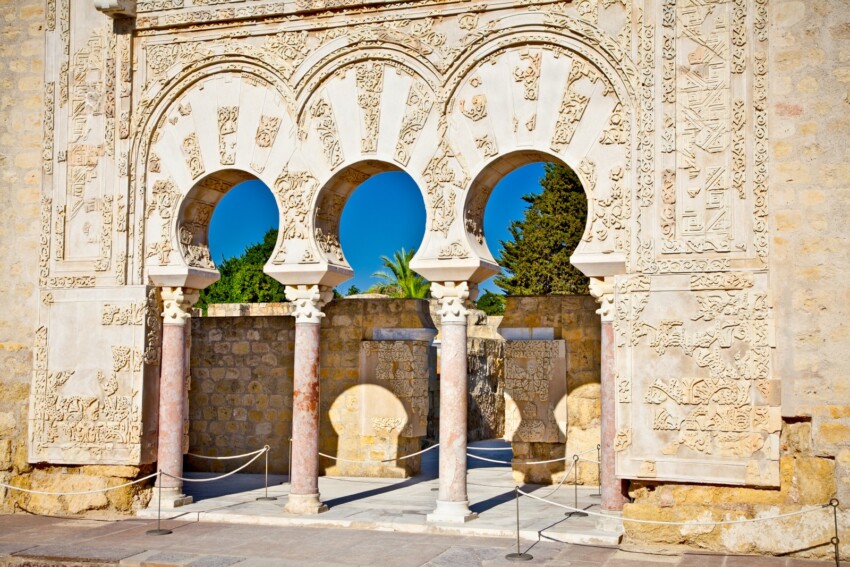
Less than 10 km from Cordoba is Medina Azahara, one of the most important archaeological sites in Spain: the ruins of a sumptuous palace-cittadella built by Caliph Abd ar-Rahman III in the 10th century.
The entire complex stood on the slopes of a hill; the area currently open to visitors corresponds to the caliph’s palace, located on the highest levels from which one can enjoy a beautiful view of the gardens.
There is a museum that tells the history of Medina Azahara.
In the following map you can see the location of the main places of interest mentioned in this article.
Discover Cordoba through the eyes of expert guides who will take you on a tour of the city's hidden treasures. Participating in a free tour will allow you to capture the true essence of Cordoba.
The free tours are a viable alternative to traditional guided tours. They work like this: participation is free and at the end of the visit you can leave a tip at your discretion. Below you will find our favourite free tour, otherwise you can see the full list by visiting this page.
What to do in Cordoba? The most popular activity for tourists is undoubtedly the guided tour of the Mezquita, but the choice of tours and activities is very wide. You can choose between walking, cycling or segway tours of the city or travel from Cordoba for a day trip to Granada or Seville.
A tapas tour is a fun way to spend an evening and experience one of the most authentically Spanish traditions.
A more unusual experience is a visit to a traditional Andalusian hacienda and bull farm: you will discover how the famous Andalusian bulls are bred and their importance in the culture of this region.
The most common choice for travellers wishing to stay at least one night in Cordoba is to sleep in the centre. There is a good choice of hotels and b&b’s close to the Mezquita and they are generally charming establishments. Having everything on your doorstep is undoubtedly a great advantage, however Cordoba includes other very beautiful areas that lend themselves perfectly to a fabulous stay.
One of the best areas to sleep in Cordoba is the Juderia. Located only a 5-minute walk from the Mezquita, it is full of charm and a little quieter; the disadvantage is the accommodation prices, which are slightly higher than in the centre.
An even quieter neighbourhood is Barrio Santa Marina, north of the centre; the neighbouring district, Barrio San Lorenzo, is livelier and is recommended for those who like a popular atmosphere. Bordered by two lively squares, Barrio San Andrés is a good compromise between historical and modern Cordoba and is recommended for those seeking budget accommodation.
All historical districts are not recommended for those travelling by car due to narrow streets and the difficulty of finding parking.
There is an airport in the city of Cordoba but it is not used for commercial flights. This means that to get to Cordoba you need to take a flight to the nearest airports (Seville, Málaga and Granada) and from there travel by hire car or public transport. All of these three airports are served by low-cost flights to/from most European cities; the closest and the one with the greatest offer of cheap flights is Seville.
For those who are already in Andalusia, getting to Cordoba by car is quite easy because the region is criss-crossed by an extensive network of state roads, motorways and main roads that allow for quick travel.
Getting to Córdoba by public transport is also easy, as long as it is between the main cities; in the small villages connections are scarce or non-existent.
Cordoba’s railway station is located at the northern end of the historical centre. It is served by AVE high-speed trains that connect Córdoba to the main Spanish cities very quickly: Seville can be reached in only 45 minutes, Madrid in less than 2 hours and Barcelona in about 5 hours. RENFE trains, which are cheaper but slower, are also in service.
Next to the train station is the bus station where you can catch direct buses to many places in Andalusia and to Madrid.
What's the weather at Cordoba? Below are the temperatures and the weather forecast at Cordoba for the next few days.
Cordoba is located in the north-central part of Andalusia, the region that occupies almost all of southern Spain. The city is about 140 km from Seville and about ten more from Malaga; Madrid is 400 km away.